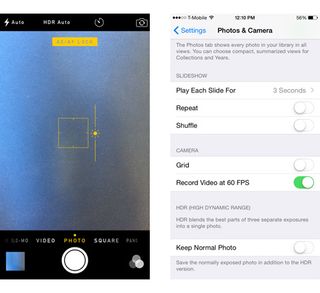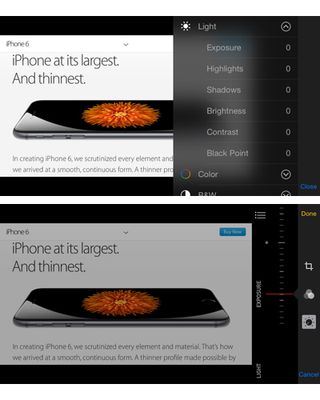Apple iPhone 6 And iPhone 6 Plus Review
The iPhone 6 and 6 Plus are bigger and better than ever, but are they a worthy upgrade for existing iPhone users? What if you previously passed over the iPhone because of its small screen, does it now merit a second look?
Why you can trust Tom's Hardware
Camera: Hardware And Software
Hardware
Apple upgraded the rear iSight camera sensor on the iPhone 4s to 8MP three years ago. Since then, we’ve seen smartphone camera pixel counts steadily increase to over 20MP, however, pixel count held steady on the iPhone 5 and 5s.
While pixel density didn’t change on the 5s, it did receive a new sensor with larger pixels (1.5µm versus the 1.4µm in the iPhone 5) to improve low-light performance. The aperture was also changed from f/2.4 to f/2.2, allowing more light to hit the sensor. The other significant change was the addition of the dual-LED True Tone flash, which blends the light from two different color LEDs to achieve better color balance.

The rear camera on the iPhone 6 uses the same optics as the 5s, and while the sensor is new, its specifications are also the same as the 5s. This new sensor contains Focus Pixels, which is just Apple’s fancy name for a technology known as phase detection autofocus (PDAF). PDAF is common in DSLR cameras and is also used in the Samsung Galaxy S5.
Previous iPhones used contrast detection autofocus, where the image signal processor (ISP) compares the change in contrast of nearby pixels at various focal distances. Focus is achieved when contrast is maximized. While less costly to implement, this method doesn’t work well in low-light conditions and is comparatively slower than other methods.
PDAF, however, is a more reliable autofocus process and achieves focus much more quickly than the contrast detection method. It works in a manner similar to an optical rangefinder. Incoming light is refracted by microlenses and the resulting images are superimposed on the AF sensor. The distance between light intensity peaks is measured, and then the ISP uses this data to determine if the image is in focus. Unlike the contrast detection method, which doesn’t know exactly how much to adjust the lens to improve focus, the PDAF method calculates the necessary adjustment, which is the secret to its speed.
![Phase Detection Autofocus [Image Source: Wikipedia]](https://cdn.mos.cms.futurecdn.net/y7iMXbSAXGpZzMBT3sEjs3-320-80.png)
The other new rear camera feature is exclusive to the iPhone 6 Plus: optical image stabilization (OIS). With OIS, the gyroscope and M8 motion coprocessor feed motion data to the ISP within the A8 SoC, which controls a voice coil in the camera that physically moves the lens assembly. This helps compensate for small vibrations caused by shaky hands to reduce motion blur for low-light images. It’s also more effective than the electronic image stabilization used on previous iPhones and still used on the iPhone 6.
The front-facing FaceTime HD camera also gets a new sensor, although it maintains the same 1.2MP resolution and 1.9μm pixels as the camera in the iPhone 5s. Aperture size is now f/2.2, improving low-light performance. There’s also better face detection and a new burst mode capable of taking 10 photos per second.
The A8’s ISP gets some enhancements, enabling new features and boosting video capture speeds. The iSight camera now captures HD video at 1080p/60 FPS, and slow-motion 720p video at either 120 or 240 FPS. The higher frame rate for HD video helps action scenes look smoother. Video on the go is further improved by cinematic video stabilization, which uses software to reduce small, jittery movement and helps keep the video looking steady.
Software
The Camera app remains largely unchanged in iOS 8, still functioning as a point-and-shoot camera. However, tapping the screen now shows an exposure control next to the focus box. Sliding the control lightens or darkens the photo or video by up to four f-stops in each direction. There’s also a shot timer that can be set for either a three- or 10-second delay, and a new mode for shooting time-lapse videos. Unfortunately, the time-lapse feature doesn’t provide any control over the playback speed or duration of capture. Depending on how much action is in a scene, the default playback speed isn’t always appropriate.
The only other addition to the interface is a toggle in the lower-right corner for setting the recording speed when shooting slow motion video. Unfortunately, there isn’t a similar toggle when shooting HD video. Instead, the option to record 60 FPS video resides in the “Photos & Camera” section in the Settings app.

The Photos app gains some new image editing options for adjusting brightness and color. You can either use a simple slider and let the Photos app handle the details, or you can expand the menu to access manual controls.

With iOS 8 it’s now possible to take and share photos directly from the Lock screen. Tapping the share button and entering your passcode or using Touch ID accesses the sharing options. It's a simple change, but a big improvement in usability.
Current page: Camera: Hardware And Software
Prev Page Apple’s A8 SoC: GPU And The Uncore Next Page Camera: Photo QualityStay on the Cutting Edge
Join the experts who read Tom's Hardware for the inside track on enthusiast PC tech news — and have for over 25 years. We'll send breaking news and in-depth reviews of CPUs, GPUs, AI, maker hardware and more straight to your inbox.
-
blackmagnum Everyone would want to own one and be the envy of their peers. They want a device that is attractive, well-made and intuitive. That's how Apple sells them by the millions, don't you agree?Reply -
lanbaner Nvidia has a better GPU. The G3 has a better display. The Note 4 has better camera. Gone are the days were the iPhone was the leader on all fronts. Would be nice to see all the strengths from the competition in one phone. Considering the transition to 20nm for Maxwell early next year we could possibly see an iPhonekiller on all aspects. Although I have to agree that the build quality on the iPhones is always top notch.Reply -
M3God Other then just sticking to just 1GB internal memory, there is no mention that apple switched to cheaper and slower TLC memory to make more profits while screwing the customer. The TLC memory has been linked to crashes and bootloops that require a trip to the apple store.Reply -
aaaas I browse the Web and talk on the phone on Verizon all the time. At least the last two generations of devices have been able to do this... at least for android...Reply
Interesting article, as I've been considering a switch to iphone. -
KaptainK " Wi-Fi calling is currently only supported by T-Mobile in the U.S."Reply
Not True! Republic Wireless has been using wi-fi calling for years. Republic also includes a feature where it will hand the call off from wi-fi to cellular if you leave the wi-fi zone during the call. Does the iPhone do this?? -
cknobman A. Thanks for including the Lumia 1520 in the comparison chart of phablets, most other sites dont do this.Reply
B. The price for the 6 plus in that same chart ($299) is on contract while every other device price is off contract.
As a whole if you are an iPhone user I am sure you are happy with the changes made to the 6. Outside of that the iPhone "cool factor" ship has sailed and this wont be winning over many Android users. -
cmi86 How can this guy sit here and hump apples leg by saying the A8 should be competitive if not class leading when it's competition averages over 1Ghz higher clock speed and 2 more cores.... I know a lot of people doing reviews now a days feel obligated to shine up certain companies and make their products appear in a positive light. This is not that... this is a blatant lie.Reply -
SirKnobsworth How can this guy sit here and hump apples leg by saying the A8 should be competitive if not class leading when it's competition averages over 1Ghz higher clock speed and 2 more cores.... I know a lot of people doing reviews now a days feel obligated to shine up certain companies and make their products appear in a positive light. This is not that... this is a blatant lie.Reply
Clock speeds and core counts can be deceptive, the key point here being that Apple's Cyclone cores can execute about twice as many instructions per clock cycle as most of their competitors. This shows up in the benchmarks - the iPhone 6 and 6+ do very well in single threaded tests, though tend to lag behind competitors in multithreaded tests like physics. Note that this is also the approach that Nvidia is taking with their Denver cores - fewer, bigger cores as opposed to more small cores.
How this translates into actual performance will vary of course - most smartphone workflows aren't particularly well threaded so having four cores as opposed to two probably won't make a huge difference in many situations, but I'm sure there are plenty of exceptions. -
ZXS ReplyDue to their zero reading on the black level tests, AMOLED displays are said to have an infinite contrast ratio.
MATT, do you know this is Samsung's marketing BS?
Smartphone displays reflect about 6% of incoming light (which is much more than LCD backlight emits). Actual contrast of AMOLED is worse than that of LCD since the reflections are so high, but maximum brightness is much lower than that of LCD.
